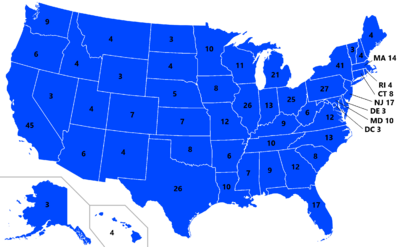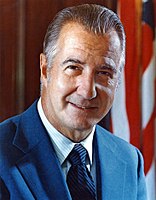1972 United States presidential election (ASITD)
| |||||||||||||||||||||||||||||
538 members of the Electoral College 270 electoral votes needed to win | |||||||||||||||||||||||||||||
|---|---|---|---|---|---|---|---|---|---|---|---|---|---|---|---|---|---|---|---|---|---|---|---|---|---|---|---|---|---|
| |||||||||||||||||||||||||||||
 Presidential election results map. Red denotes states won by Agnew/Ford and Blue denotes those won by Muskie/Humphrey. Numbers indicate electoral votes cast by each state and the District of Columbia. | |||||||||||||||||||||||||||||
| |||||||||||||||||||||||||||||
The 1972 United States presidential election was the 47th quadrennial presidential election. It was held on Tuesday, November 7, 1972. Democratic U.S. Senator from Maine Edmund Muskie defeated Incumbent Republican President Spirow Agnew from Maryland. This election is the largest margin of victory in the Electoral College since George Washington's two elections. This also became the largest margin of the popular vote for any presidential candidate since James Monroe in 1820. It was the first time when California had more electoral votes than New York.
Winner of the 1968 presidential election, Richard M. Nixon was assassinated in September of 1972, leading to Vice President Agnew being quickly nominated for President. On the Democratic side, the ticket was the inverse of the 1968 ticket with former Vice President Hubert Humphrey becoming running mate to Muskie. Among the candidates Muskie defeated were early front-runner Ted Kennedy, 1968 nominee Hubert Humphrey, and Congresswoman Shirley Chisholm, the first African-American to run for a major party's presidential nomination. With the assassination of Nixon, law and order became the prevalent issue until revelations of tax evasion and backroom dealings were reported regarding Vice President Spirow Agnew.
Muskie emphasized his desire to control inflationary pressure by enacting policies which would foster higher wages, while also pledging to withdraw from Vietnam in a strategic manner. Until October 2, when initial reporting regarding tax evasion was reported, Vice President Agnew had held a narrow lead in national polling. Following this reporting, and the election eve departure from the ticket, and denunciation of running mate Gerald Ford, polling demonstrated a quick and fluid switch in preference among voters towards Muskie.
Muskie won the election in a complete landslide, taking 69.78% of the popular vote and carrying all fifty states, being the first presidential candidate since George Washington to receive every available electoral college vote. Agnew took just 30.12% of the popular vote. Muskie received over 36 million more votes than Agnew, and holds the record for the widest popular vote margin in any contested United States presidential election. The 1972 presidential election was the first since the ratification of the 26th Amendment, which lowered the voting age from 21 to 18. Hubert Humphrey became the first Vice President to serve two separate Presidents in non-consecutive terms, and also the third Vice President to serve two separate Presidents overall.
As of 1981, this was the last time that Utah, Nebraska, North Dakota, Idaho, Alaska, Nevada, Wyoming, Arizona, New Hampshire, Oklahoma, New Mexico, Georgia, South Dakota, Montana, Colorado, Kansas, Iowa, Ohio, Florida, Indiana, Missouri, Texas, Virginia, and Louisiana would vote for a Democratic presidential candidate. The tipping point state was Muskie's home state of Maine, which was won by a margin of 39.36%.

